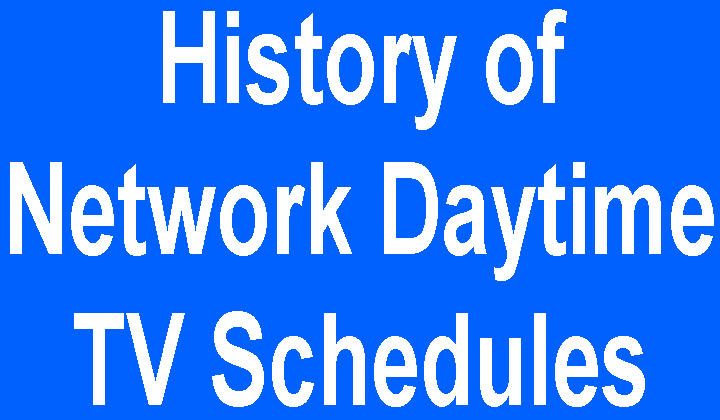 Home
DFS
SB
OD
SDN
DFSM
THP
$5
Home
DFS
SB
OD
SDN
DFSM
THP
$5
NBC picked up the show "Queen for a Day" for national broadcast from January 2, 1956 to September 2, 1960, and aired it live across the nation (1:30 PST in Los Angeles and 4:30 EST in New York). It may have been possible that Pacific Time zone feeds were already working by then since many NBC shows aired on a different pattern there. What pattern the TV stations in the Pacific time zone used is unknown and is being researched.
What is known are the NBC TV schedules for the Eastern time zone in the 1940s and afterwards, and it was possible that there might have been a feed for the Pacific Time zone to feed its affiliates by 1951 when coast-to-coast transmission of TV signals began. We're not sure what year, but the purpose of the Pacific Time zone feed is for the flagship network TV companies based in Los Angeles would tape the TV transmissions coming from their New York parent companies, and rebroadcast most of them on tape delay to feed their TV affiliates to better serve the audience in the Pacific Time Zone. As for Daytime, the early days before coast-to-coast transmission might have been bicycling the tapes recorded from aiming a camera at a television set and sending the tapes to their affiliates for later transmission, or having distant affiliates rebroadcast network programming from a nearby affiliate (with permission of course) on their TV station. It was chaos in the early days of network television as we didn't know if the same shows were on in the same day nationwide or delayed for up to a week.
What is not known is what the four broadcast networks's daytime programming patterns on the Pacific Time Zone were for most of the 1950s decade, but as the Los Angeles TV stations are the primary hubs for network programming for the Pacific Time Zone, we'll be using what we know for this purpose, as they may give a clue on what times the daytime network shows would have been airing on the left coast.
The Eastern feed from the networks are the primary network feeds, as it feeds their progamming in real time to TV stations and network hubs across the country. Most of the shows that air at certain times on the East coast are seen what appears to be one hour earlier for the same shows in the Central Time Zone. For example, NBC's Wonderful World of Disney in the 1960s broadcasted Sunday nights at 7:30pm Eastern, but appears at 6:30pm Central time. This is real time because time zones are divided and clocks are set one hour earlier as you go Westward from the Eastern time zone to the Pacific time zone. In real time, Disney aired at 12:30am Monday morning UTC time as the official world time stamp of the broadcast. We'll use Standard time and not Daylight time for our examples.
What the daytime schedule looked like on NBC's Pacific feed in the 1950s prior to 1956 is not yet known, as not all TV stations yet had direct access to coast-to-coast feeds from New York. Once coast-to-coast transmissions were initiated, prior to having their own Pacific feed, and for those that bought receiving equipment that would receive the Eastern feeds, the TV stations in the Pacific time zone might have broadcasted many daytime shows live off the Eastern feed if they didn't have enough means of mechanical recording equipment to tape delay the shows to be seen later in the day. It is possible that once the networks began offering Pacific Time Zone feeds, TV affiilates slowly phased in the times of the shows off of that feed once they were fitted with network feed receiving equipment for direct broadcasting live from that feed instead of relying on taping from the Eastern feed, relying on a nearby affiliate that might pre-empt a network show the rebroadcasting station planned to air, or having the network shows bicycled into the station.
If you ever went to the Mountain Time Zone in Phoenix, Arizona, or Denver, Colorado, for example, you might have noticed that most of the daytime TV shows seen there were broacasted direct from the Eastern feed and a few tape delayed to air after the daytime network feeds ended for the day. Prime-time shows had to be taped and delayed since there was no Mountain time zone feed in order for the shows to be seen following a Central time zone pattern (one hour after they aired on the East coast), or in some cases, the first hour (7:30-8:30pm ET, appearing from 5:30-6:30pm MT) was taped and delayed to air at 9pm Mountain time after the network prime time programming block ended. The Daytime shows were aired mostly live from the Eastern feed with, for example, the game show "Three on a Match" with host Bill Cullen, a 1:30pm ET/12:30pm CT/12pm PT show, aired in the Mountain Time Zone at 11:30am; during Daylight Saving Time, however, in which Arizona does not to this day participate in, that game show aired at 10:30am in Yuma, Phoenix, Flagstaff and Tucson (four Arizona cities had NBC affiliates then) when the rest of the nation was on Daylight Saving Time.
In late 1955, NBC picked up the show "Queen for a Day" with the purpose of having housewives across the coast, using the coast-to-coast feed, to call into the show and vote for their Queen for the episode. The best time NBC could program the show would be in the hour at 4pm Eastern time, which in real time would be 3pm Central, 2pm Mountain, and 1pm Pacific time. In order to help the Pacific TV stations out, NBC cratered their daytime schedule in 1956 with a two-hour dark zone and resumed broadcasting their daytime shows from 3pm to 6pm Eastern. NBC began their daytime schedule with a three hour block from 10am to 1pm Eastern. TV stations in the Pacific time zone might have taped the shows that aired from 10am to 12pm Eastern and delayed them to air from 10am to 12pm Pacific. The 12pm-1pm Eastern shows might have been airing live in the Pacific time zone from 9am to 10am. Then, at noon Pacific, when NBC resumed daytime programming, the second three-hour block of daytime programs aired from 12pm until 3pm when NBC signed off its daytime programming for the day.
So premiering on January 2, 1956, was "Queen for a Day", airing at 4:30pm Eastern, 1:30pm Pacific. Four of the six hours of NBC's programming directly from the Eastern feed onto the Pacific time zone stations. It's possible that there might have been a Pacific feed already, which in that case, would result in a slightly altered pattern of TV shows, but would be fed from 9am to 3pm anyway.
Beginning on June 4, NBC shifted its late three-hour block of shows ahead one hour from 3-6pm to 2:30-5:30pm Eastern time. "Queen" still aired at 4:30ET/1:30PT, but would be expanded to 45 minutes on July 2 to begin at 4pm ET/1pm PT. NBC's East coast feed had a 90 minute dark zone from 1-2:30pm Eastern and gave the 5:30pm half hour to its affilliates in exchange of taking the 2:30pm half hour.
This also meant that for the Pacific time zone TV stations, the show that aired at 2:30pm Eastern would be appearing at 11:30am Pacific, and TV affiliates that chose to air the Tennessee Ernie Ford show would tape delay it to air at 2:30pm Pacific, after the Comedy Time show at 2pm Pacific (5pm Eastern).
In 1957, NBC added Close-Up from 1-1:30pm ET, followed by Club 60 from 1:30-2:30pm ET. It might have been possible that some Pacific time zone affiliates might have taped it to air later in the day if they chose to air it. What is not known is when. Possibly in the 3-4:30pm range? "Queen" aired live there from 1-1:45pm PT followed by a 15-minute serial Modern Romances.
On January 13, 1958, NBC dropped "Club 60" and gave the 1:30-2:30 ET time slot back to their affiliates. On February 3, 1958, NBC dropped "Close-Up" and gave the 1pm ET time slot back to their affiliates. I'm guessing that not many affiliates chose to carry those two programs and favored local programming instead. It was otherwise a seven and a half hour long daytime schedule that was a bit long for small market TV affiliates to fit into their schedules.
On June 30, 1958, NBC added a show at 2pm Eastern time, and on August 18, NBC gave the 5pm half hour back to their affiliates. Pacific time zone affiliates would run the afternoon shows in this pattern: 12pm-2pm: Live from the Eastern feed 3pm-5pm ET, 2pm-3pm: tape delayed from the Eastern feed airing 2pm-3pm ET (real time 11am to 12pm PT).
"Queen" continued to air from 4-4:45pm ET live until September 22, 1958, when the show was contracted to 30 minutes, airing live from 4-4:30pm ET (1-1:30pm PT).
On March 30, 1959, NBC moved "Queen" to 2pm ET, meaning that it would air at 11am PT. It is possible that a Pacific time zone feed from Los Angeles's NBC flagship western hub might have been operational by then and the NBC hub could handle the process of taping the shows from the Eastern hub and schedule them to be sent later in the day to its affiliates in the Pacific Time Zone. What the NBC Pacific feed for daytime looked like was that the 10am-1pm ET shows would air from 9am-12pm PT, and the 2pm-5pm ET shows would air from 12pm-3pm PT. But according to research, I found "Queen" airing on KNBC (then-called KRCA) airing on a one-hour tape delay at 12pm instead of 11am when it aired live across the nation (or 2pm ET). Was it possible that network affiliates aired "Queen" live and taped "Tic Tac Dough" or Truth or Consequences" airing at 11am PT to air at a later time such as 12pm (to plug the Pacific feed of the tape-delayed Queen) or 3pm if they ran local programming at noon?
"Queen" continued to air either live or tape-delayed on the PT until NBC aired its last episode on September 2, 1960. Once "Queen" ended, many left coast stations began or have finished phasing in the NBC Pacific feed scheduling pattern instead of airing the shows live from the NBC Eastern feed.
As you have seen in the 1950s, NBC's daytime schedule was anarchy at best before the NBC (or other networks) begain offering their Pacific Time Zone feeds to their affiliates to provide a more uniform schedule for Western stations. NBC's western stations had the luxury of programming local such as kid show hosted cartoon shows, movies, syndication, talk shows and even early news beginning at 3pm PT. Some stations in the Eastern and Central might have tape delayed the late network daytime shows to air earlier the following day so they could run children's programming and more between 3 to 5pm.
NBC continued to feed the Pacific time zone stations afternoon programming from 12pm-3pm with programming at first that originally began airing one hour earlier on the Eastern feed (2pm-5pm ET is 11am-2pm PT). Once "Queen" left NBC's schedule after September 2, 1960, the Pacific time zone affiliates simply aired what was live on the Pacific feed at 11am and 12pm PT.
NBC's late afternoon shows (2-5pm ET, 12-3pm PT) featured The Jan Murray Show, The Loretta Young Theater, Young Dr. Malone (serial), From These Roots (serial), Comedy Playhouse and Adventure Time, and later on, Here's Hollywood, Make Room For Daddy, Our Five Daughters (serial), and The Merv Griffin Show. Most of the shows had this time zone announcement pattern: 2pm, 1pm CT and 12pm PT; 2:30pm, 1:30pm CT and 12:30pm PT; 3pm, 2pm CT and 1pm PT; 3:30, 2:30pm CT and 1:30pm PT; 4pm, 3pm CT and 2pm PT; and 4:30, 3:30pm CT and 2:30pm PT.
On December 31, 1962, NBC debuted the first incarnation of "The Match Game" hosted by Gene Rayburn. It aired at 4pm ET, 3pm CT and 2pm PT.
On April 1, 1963, NBC actually debut two serials: "Ben Jerrod" at 2, 1 CT and 12 PT, and "The Doctors" at 2:30, 1:30 CT and 12:30 PT. The former lasted until June 28 of that year. Also on April 1, the game show "You Don't Say" hosted by Tom Kennedy began airing at 3:30, 2:30 CT and 1:30 PT.
On December 30, 1963, NBC premiered the game show "Let's Make a Deal" with host Monty Hall, airing at 2, 1 CT and 12 PT.
On May 4, 1964, NBC premiered the serial "Another World" airing at 3, 2 CT and 1 PT.
On June 29, 1964, NBC gave the 4:30pm ET show to its affiliates in exchange of taking the 1:30 ET time slot. On the same day, NBC moved "Let's Make a Deal" to 1:30 ET. As a result, NBC's Pacific Feed from 12pm-3pm tape-delayed shows that began 90 minutes earlier on the Eastern Feed. The 1:30pm to 4:30pm ET shows aired from 12pm to 3pm PT. On the Pacific Feed, "Deal" remained at 12pm, but NBC inserted "The Loretta Young Theater" at 12:30 PT (2:30 ET), resulting in the two late soaps and game shows to be pushed back by a half hour with The Doctors moving from 12:30 to 1, Another World moving from 1 to 1:30, You Don't Say moving from 1:30 to 2, and The Match Game moving from 2 to 2:30; those same four shows did not move time periods on the Eastern Feed.
So most of the shows had this time zone pattern since then: 1:30, 12:30 CT and 12pm PT; 2, 1 CT and 12:30 PT; 2:30, 1:30 CT and 1 PT; 3, 2 CT and 1:30 PT; 3:30, 2:30 CT and 2 PT; and 4, 3 CT and 2:30 PT.
On January 4, 1965, NBC premiered the serial "Moment of Truth" to air at 2, 1 CT and 12:30 PT. This helped NBC form a 90 minute serial block. It was replaced on November 8 by a serial that lasted much longer, "Days of Our Lives" in the same time slot.
On December 30, 1968, "Let's Make a Deal" shifts from NBC to ABC due to contract disputes with owner/producer and host Monty Hall. ABC scheduled "Deal" to air at 1:30, 12:30 CT and 1:30 PT. It was in the same time slot as it was on coasts other than on the Pacific time zone because back then ABC aired its programs on the Pacific feed three hours after they began airing on its Eastern feed. At 1:30pm, 12:30pm CT and 12pm PT, NBC tried many shows, but only "Three on a Match", a game show hosted by Bill Cullen, lasted the longest.
On September 29, 1969, NBC pulled "You Don't Say" and "Match Game" off and replaced one of them with a serial "Bright Promise" and other programiming at 3:30pm, 2:30pm CT and 2 PT; the other was replaced with various programs before settling on "Somerset", a serial that was a spin-off of "Another World" at 4, 3 CT and 2:30 PT, on March 30, 1970.
On April 3, 1972, "Bright Promise" was replaced with "Return To Peyton Place" at 3:30, 2:30 CT and 2pm PT; then on January 7, 1974, it too was replaced with "How To Survive A Marriage."
On January 6, 1975, NBC moved "Survive" to 1:30, 12:30 CT and 12 PT in its final attempt to program a half-hour show and expanded "Another World" to a full hour to air at 3, 2 CT and 1:30 PT. After seeing sucess in expanding AW, it decided to solve its long time problem with the 1:30pm ET slot by expanding "Days of Our Lives" to a full hour, effective April 21, 1975. When they did, the NBC late afternoon shows did not change time slots on the Eastern feed as they simply expanded "Days" backwards by adding 30 minutes of it in front of their old 30 minute time slot so that instead of airing from 2-2:30pm ET, it aired from 1:30-2:30pm ET. On the Pacific feed, however, "Days" still began at 12:30 PT, but it pushed all of the later shows back a half an hour, resulting in "The Doctors" at 1:30, "Another World" at 2, and "Somerset" at 3. On this date, the Pacific feed daytime slotting was the same as that in the Central Time zone, even adding a 30-minute dark zone from 12-12:30pm for local programming on the west coast.
In the days prior to NBC shifting their late afternoon schedule up a half an hour to remove the dark feed break at 12pm, some NBC affiliates in the Pacific time zone might have aired the 3pm NBC shows at 12pm so they could begin local programming at 3pm.
On January 3, 1977, NBC replaced "Somerset" with "The Gong Show", which premiered in 1976 in an earlier time slot at 12:30pm/11:30am CT and PT. "Gong" aired at either 3pm or 12pm Pacific depending on the NBC station that chose to air the show.
On December 5, 1977, NBC eliminated its 30-minute 1pm/12pm CT and PT break and gave the 4/3 CT and PT 30-minute slot back to their affiliates. They programmed various shows in the 1/ 12 CT and PT time slot until expanding "Another World" to 90 minutes on March 5, 1979, which had a reverse domino effect, as "Days" and "Doctors" would begin airing a half hour earlier, as did "World", eliminating the 1/12pm CT and PT time slot problem. "Days" at 1/12 CT and PT, followed by "Doctors" at 2/1 CT and PT then "World" at 2:30/1:30 CT and PT.
That's very much the story of NBC's Pacific Feed history from the 1950s to the 1970s. Since then, affiliates would be running many of the NBC shows at different times than those the network fed them, such as KNSD in San Diego swapping "Santa Barbara" with "Days" to air at 12pm and 2pm respectively in September 1988.
As of 2007, "Days" is NBC's sole non-news daytime program, and affiliates run it very much in any time slot it feels like airing it.
© 1995-2025. davesfunstuff.com. All Rights Reserved. Reproduction of any part of this website without expressed written consent is prohibited.



